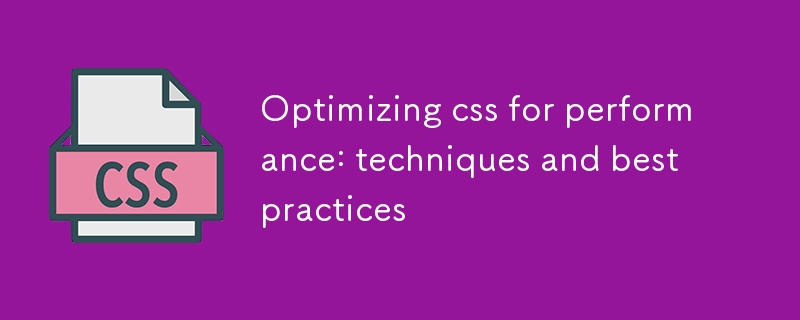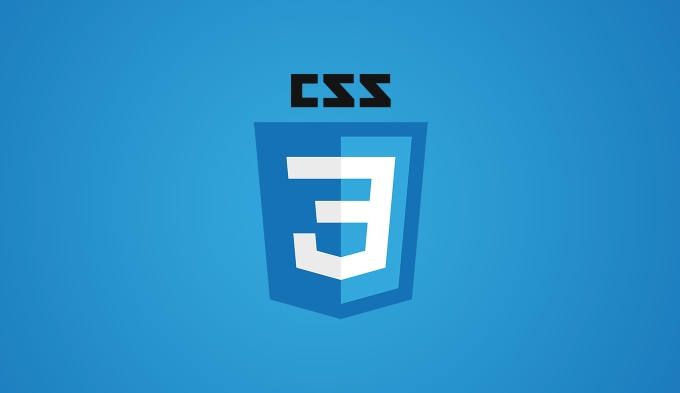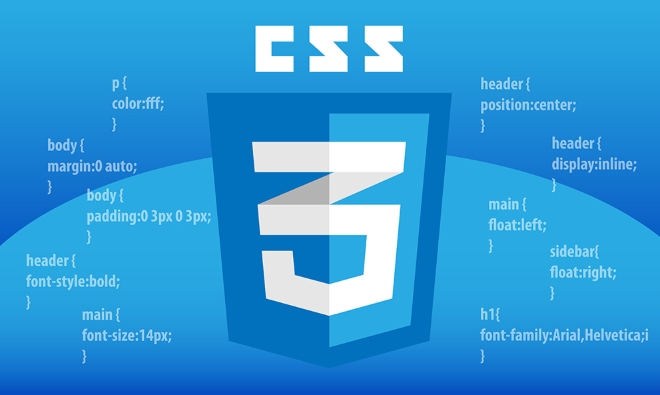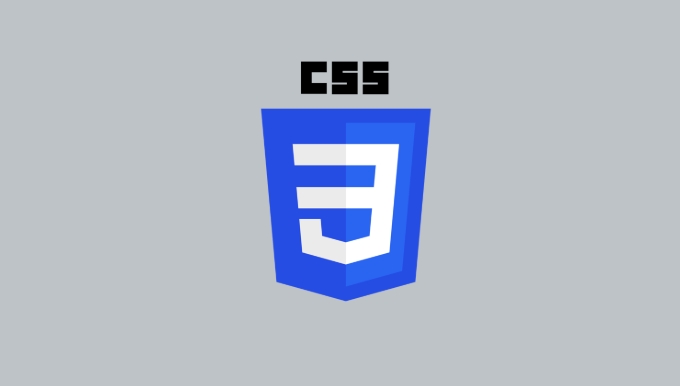Optimizing css for performance: techniques and best practices
Jul 10, 2025 pm 02:07 PMTo optimize CSS for faster websites, first minify and combine CSS files to reduce size and HTTP requests. Second, use efficient selectors by avoiding overqualification and deep nesting. Third, leverage critical CSS by inlining essential styles and loading non-critical CSS asynchronously. Fourth, remove unused CSS with tools like PurgeCSS or Chrome DevTools. These steps improve load times, rendering performance, and user experience without sacrificing maintainability.

When it comes to making websites fast, optimizing CSS is often overlooked but incredibly impactful. Clean, efficient CSS can reduce load times, improve rendering performance, and make your site feel snappier — especially on mobile or slower connections.

Here's how to get the most performance out of your CSS without sacrificing maintainability or design quality.

Minify and Combine CSS Files
One of the easiest ways to speed up CSS delivery is to reduce the number of requests and the size of what’s being loaded.
- Minifying removes unnecessary characters like whitespace, comments, and line breaks.
-
Combining multiple CSS files into one reduces HTTP requests (or saves from relying too much on
@import, which can block rendering).
Most build tools like Webpack, PostCSS, or even simple online minifiers can help with this. Just be careful not to over-combine — if you have separate styles for print or older browsers, keep those isolated so they're only loaded when needed.

If you're using a modern framework, check if it automatically handles this during the build process. For static sites, a quick script or plugin can automate it during deployment.
Use Efficient Selectors and Avoid Overqualification
CSS selectors might seem harmless, but inefficient ones can slow down rendering.
- Avoid overly specific selectors like
div#main-content ul.nav > li.active a - Don’t “overqualify” elements unnecessarily:
.my-classis better thandiv.my-class
Browsers read selectors from right to left. So something like ul#nav li.active makes the browser check every li on the page before applying any filtering by class or parent. It's not usually a big issue in small projects, but it adds up on large sites.
Stick to classes wherever possible. IDs are fast, but not always necessary. And descendant selectors like section p are fine, but avoid deep nesting unless you really need that level of specificity.
Leverage Critical CSS and Async Loading
Rendering performance matters more than ever. If your CSS blocks the page from showing content quickly, users will notice.
- Extract and inline critical CSS — the minimal styles needed to render above-the-fold content.
- Load the rest of your CSS asynchronously using techniques like
rel="preload"or JavaScript-based loading.
Tools like Critical or plugins for popular frameworks can help extract critical CSS automatically. You can also do it manually for simpler sites.
Inlining just 5–10KB of critical CSS in the can eliminate render-blocking resources and make pages feel faster. The non-critical CSS can be deferred until after the initial render.
Reduce Unused CSS
Many sites ship CSS that never gets used. That’s wasted data and extra parsing time.
- Use tools like PurgeCSS, UnCSS, or Chrome DevTools' Coverage tab to find unused styles.
- Especially useful in component-based apps or when using large CSS frameworks like Bootstrap or Tailwind.
Tailwind users, for example, should always run PurgeCSS in production. Otherwise, you end up shipping hundreds of unused utility classes.
It’s worth noting that some frameworks generate dynamic class names or rely on runtime logic — so test thoroughly after removing unused CSS. But for most sites, trimming dead code is a solid win.
Optimizing CSS isn't hard once you know what to focus on. Start with minification and combining, clean up your selectors, extract critical styles, and remove unused code. Most of these steps can be automated, so you don’t have to worry about them every time you deploy.
That’s basically it — straightforward, effective, and easy to maintain once set up.
The above is the detailed content of Optimizing css for performance: techniques and best practices. For more information, please follow other related articles on the PHP Chinese website!

Hot AI Tools

Undress AI Tool
Undress images for free

Undresser.AI Undress
AI-powered app for creating realistic nude photos

AI Clothes Remover
Online AI tool for removing clothes from photos.

Clothoff.io
AI clothes remover

Video Face Swap
Swap faces in any video effortlessly with our completely free AI face swap tool!

Hot Article

Hot Tools

Notepad++7.3.1
Easy-to-use and free code editor

SublimeText3 Chinese version
Chinese version, very easy to use

Zend Studio 13.0.1
Powerful PHP integrated development environment

Dreamweaver CS6
Visual web development tools

SublimeText3 Mac version
God-level code editing software (SublimeText3)

Hot Topics
 What is 'render-blocking CSS'?
Jun 24, 2025 am 12:42 AM
What is 'render-blocking CSS'?
Jun 24, 2025 am 12:42 AM
CSS blocks page rendering because browsers view inline and external CSS as key resources by default, especially with imported stylesheets, header large amounts of inline CSS, and unoptimized media query styles. 1. Extract critical CSS and embed it into HTML; 2. Delay loading non-critical CSS through JavaScript; 3. Use media attributes to optimize loading such as print styles; 4. Compress and merge CSS to reduce requests. It is recommended to use tools to extract key CSS, combine rel="preload" asynchronous loading, and use media delayed loading reasonably to avoid excessive splitting and complex script control.
 External vs. Internal CSS: What's the Best Approach?
Jun 20, 2025 am 12:45 AM
External vs. Internal CSS: What's the Best Approach?
Jun 20, 2025 am 12:45 AM
ThebestapproachforCSSdependsontheproject'sspecificneeds.Forlargerprojects,externalCSSisbetterduetomaintainabilityandreusability;forsmallerprojectsorsingle-pageapplications,internalCSSmightbemoresuitable.It'scrucialtobalanceprojectsize,performanceneed
 Does my CSS must be on lower case?
Jun 19, 2025 am 12:29 AM
Does my CSS must be on lower case?
Jun 19, 2025 am 12:29 AM
No,CSSdoesnothavetobeinlowercase.However,usinglowercaseisrecommendedfor:1)Consistencyandreadability,2)Avoidingerrorsinrelatedtechnologies,3)Potentialperformancebenefits,and4)Improvedcollaborationwithinteams.
 CSS Case Sensitivity: Understanding What Matters
Jun 20, 2025 am 12:09 AM
CSS Case Sensitivity: Understanding What Matters
Jun 20, 2025 am 12:09 AM
CSSismostlycase-insensitive,butURLsandfontfamilynamesarecase-sensitive.1)Propertiesandvalueslikecolor:red;arenotcase-sensitive.2)URLsmustmatchtheserver'scase,e.g.,/images/Logo.png.3)Fontfamilynameslike'OpenSans'mustbeexact.
 What is Autoprefixer and how does it work?
Jul 02, 2025 am 01:15 AM
What is Autoprefixer and how does it work?
Jul 02, 2025 am 01:15 AM
Autoprefixer is a tool that automatically adds vendor prefixes to CSS attributes based on the target browser scope. 1. It solves the problem of manually maintaining prefixes with errors; 2. Work through the PostCSS plug-in form, parse CSS, analyze attributes that need to be prefixed, and generate code according to configuration; 3. The usage steps include installing plug-ins, setting browserslist, and enabling them in the build process; 4. Notes include not manually adding prefixes, keeping configuration updates, prefixes not all attributes, and it is recommended to use them with the preprocessor.
 What are CSS counters?
Jun 19, 2025 am 12:34 AM
What are CSS counters?
Jun 19, 2025 am 12:34 AM
CSScounterscanautomaticallynumbersectionsandlists.1)Usecounter-resettoinitialize,counter-incrementtoincrease,andcounter()orcounters()todisplayvalues.2)CombinewithJavaScriptfordynamiccontenttoensureaccurateupdates.
 CSS: When Does Case Matter (and When Doesn't)?
Jun 19, 2025 am 12:27 AM
CSS: When Does Case Matter (and When Doesn't)?
Jun 19, 2025 am 12:27 AM
In CSS, selector and attribute names are case-sensitive, while values, named colors, URLs, and custom attributes are case-sensitive. 1. The selector and attribute names are case-insensitive, such as background-color and background-Color are the same. 2. The hexadecimal color in the value is case-sensitive, but the named color is case-sensitive, such as red and Red is invalid. 3. URLs are case sensitive and may cause file loading problems. 4. Custom properties (variables) are case sensitive, and you need to pay attention to the consistency of case when using them.
 Case Sensitivity in CSS: Selectors, Properties, and Values Explained
Jun 19, 2025 am 12:38 AM
Case Sensitivity in CSS: Selectors, Properties, and Values Explained
Jun 19, 2025 am 12:38 AM
CSSselectorsandpropertynamesarecase-insensitive,whilevaluescanbecase-sensitivedependingoncontext.1)Selectorslike'div'and'DIV'areequivalent.2)Propertiessuchas'background-color'and'BACKGROUND-COLOR'aretreatedthesame.3)Valueslikecolornamesarecase-insens






